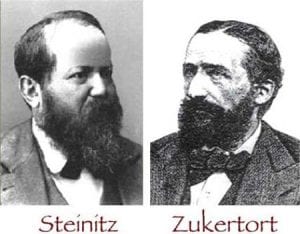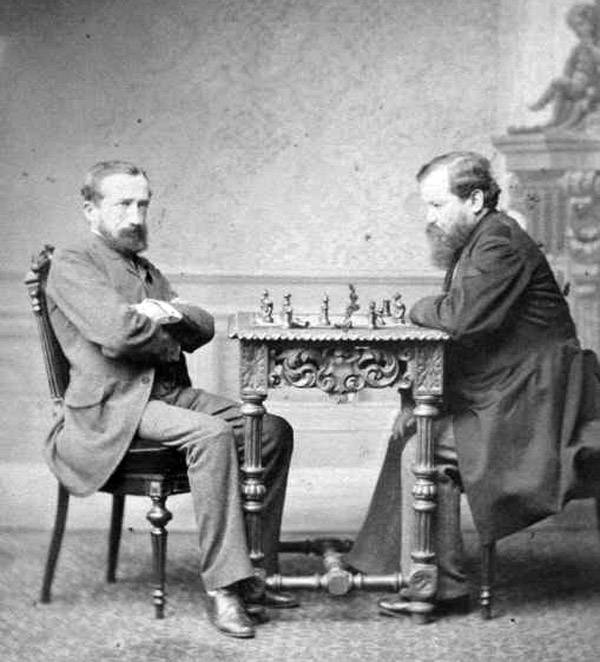Starting from 1834, regular chess matches have been organized between the strongest players on the planet:
- La Bourdonnais – McDonnell match in 1834
- Saint-Amant – Staunton match in 1843
- Staunton – Saint-Amant rematch in 1843
- Staunton – Horwitz match in 1846
- Morphy – Anderssen match in 1858
However, although the winners of all these matches have occasionally been called as the champions of the World, the title of the ‘World Chess Champion’ was not yet an official term.
In the early 60s, Wilhelm Steinitz, born in Prague in Bohemia, profiled himself on the chess scene after convincing victories in the Vienna 1861 and London 1862 tournaments. He built upon this successes in subsequent years, by winning the London tournaments in 1866 and 1872 and Vienna tournament in 1873, gaining the status of the strongest player on the planet.
Also, he reinforced that status by beating his contemporaries quite convincingly in match play. He played and won unofficial matches against:
- Anderssen in 1866
- Zukertort in 1872
- Blackburne in 1876
After his match against Blackburne, it would take Steinitz six years to propose another match. Only in 1882 did he challenge Johannes Zukertort, a Polish master, to another match, but the negotiations failed. However, after Zukertor’s victory at the prestigious London 1883 tournament, the discussion regarding the strongest player on the planet was once again reopened.
(There is a fun anecdote that happened at the post-tournament banquet. The president of the St. George Chess Club proposed a toast to the best chess player in the world and both Steinitz and Zukertort stood up simultaneously to thank him).
Therefore, wishing to settle this matter once and for all, Steinitz issued another challenge. Zukertort agreed to the match conditions, but his poor health after the London tournament prevented the organization of the match.
The negotiation was reinitiated later in 1883, but with difficulty. Late in the 1883 Steinitz had emigrated to the USA, and the match venue became the main disputing point. Zukertort insisted on playing on home turf in London, whereas Steinitz preferred to take the battle across the Atlantic. Finally, due to the better financial conditions in the USA, and to the fact that he was promised a rematch in London.

Finally, the conditions for the match were signed as late as December 29, 1885. The number of the games was not limited; the first player to win 10 points would be considered as a winner, with the exception that 9-9 result would be considered as a tie; the match was to be declared drawn. The time limit was set to 2 hours for 30 minutes, followed by additional hour gain for subsequent 15 moves.
The most significant part of the pre-match agreement is the first sentence, which stated that players agreed to „play a match at Chess for the Championship of the World.“ Thus, the title of the „World Champion“ was used formally for the first time. Although Steinitz would later say that he regarded himself as a World Champion already since his victory over Anderssen in 1866, the chess world would mark the year 1886 as the beginning of the World Championship era.
The match itself started on 11 January 1886. It turned out to be very bloodthirsty in terms of decisive games; 15 out of 20 games ended with a decisive result.
From the modern viewpoint, the choice of the openings was also extremely interesting. In the era of wild Gambits and romantic attacks, Zukertort played 1 d4 as White, which was extraordinary at a time. More importantly, he employed the infamous Berlin Defence with Black, a weapon whose strength would be recognized by Kramnik 114 years later and employed with deadly effect in his match against Kasparov in 2000.
Initially, the match went badly for Steinitz. After winning the first game, Steinitz then lost next four encounters, and already found himself in the critical situation. However, from game 6 he managed to steady his ship. During the remaining part of the match, Steinitz dominated; his opponent managed to score a single victory over the course of the next fourteen games, while Steinitz won eight of those.
Thus, with the score of 10-5 in terms of decisive games, Steinitz won the match and became the first World Champion in the history of chess.

